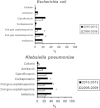Bloodstream infections and sepsis in Greece: over-time change of epidemiology and impact of de-escalation on final outcome
- PMID: 24885072
- PMCID: PMC4035827
- DOI: 10.1186/1471-2334-14-272
Bloodstream infections and sepsis in Greece: over-time change of epidemiology and impact of de-escalation on final outcome
Abstract
Background: Choice of empirically prescribed antimicrobials for sepsis management depends on epidemiological factors. The epidemiology of sepsis in Greece was studied in two large-periods.
Methods: Sepsis due to bloodstream infections (BSI) from July 2006 until March 2013 was recorded in a multicenter study in 46 departments. Patients were divided into sepsis admitted in the emergencies and hospitalized in the general ward (GW) and sepsis developing after admission in the Intensive Care Unit (ICU). The primary endpoints were the changes of epidemiology and the factors related with BSIs by multidrug-resistant (MDR) pathogens; the secondary endpoint was the impact of de-escalation on antimicrobial therapy.
Results: 754 patients were studied; 378 from 2006-2009 and 376 from 2010-2013. Major differences were recorded between periods in the GW. They involved increase of: sepsis severity; the incidence of underlying diseases; the incidence of polymicrobial infections; the emergence of Klebsiella pneumoniae as a pathogen; and mortality. Factors independently related with BSI by MDR pathogens were chronic hemofiltration, intake of antibiotics the last three months and residence into long-term care facilities. De-escalation in BSIs by fully susceptible Gram-negatives did not affect final outcome. Similar epidemiological differences were not found in the ICU; MDR Gram-negatives predominated in both periods.
Conclusions: The epidemiology of sepsis in Greece differs in the GW and in the ICU. De-escalation in the GW is a safe strategy.
Figures






References
-
- Retamar P, Portillo MM, Lopez-Prieto MD, Rodríguez-López F, De Cueto M, García MV, Gómez MJ, Del Arco A, Muñoz A, Sánchez-Porto A, Torres-Tortosa M, Martín-Aspas A, Arroyo A, García-Figueras C, Acosta F, Corzo JE, León-Ruiz L, Escobar-Lara T, Rodríguez-Baño J. Impact of inadequate empirical therapy on the mortality of patients with bloodstream infections: a propensity score-based analysis. Antimicrob Agents Chemother. 2012;14:472–478. doi: 10.1128/AAC.00462-11. - DOI - PMC - PubMed
-
- Kang CI, Kim SH, Park WB, Lee KD, Kim HB, Kim EC, Oh MD, Choe KW. Bloodstream infections caused by antibiotic-resistant gram-negative bacilli: risk factors for mortality and impact of inappropriate initial antimicrobial therapy on outcome. Antimicrob Agents Chemother. 2005;14:760–766. doi: 10.1128/AAC.49.2.760-766.2005. - DOI - PMC - PubMed
Publication types
MeSH terms
Substances
LinkOut - more resources
Full Text Sources
Other Literature Sources
Medical

